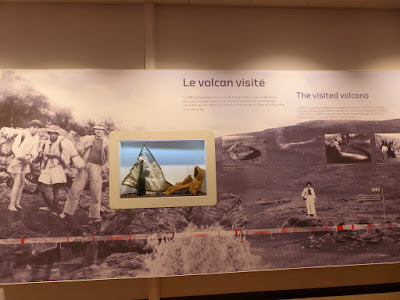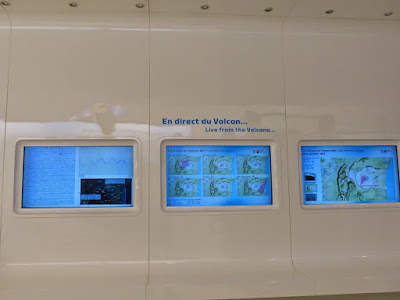Once again Reunion Island is the setting for romantic fiction in
Second Chance and its sequel
Second Chance Sister. I believe the author,
Linda Kepner, originally wrote them as one book, but that the publisher preferred to publish as two stand-alone books in 2012 and 2013 respectively. Ms Kepner lives in southern New Hampshire and has worked as a librarian, researcher, and editor, and has also written science fiction and fantasy novels as well as short stories for magazines and anthologies.
 |
| cover of Second Chance by Linda Kepner |
The story: At East Virginia University in 1969, Bishou Howard is a female Yankee graduate student in a Southern man’s academic world. Her parents are ill, and she and her brother Bat (a retired Vietnam vet) are raising their younger brothers and managing the rest of the family almost by themselves. Because of her French-Canadian background as well as her tight budget, Bishou accepts a job as an interpreter for an attendee at a university conference. Louis Dessant, a French-speaking visitor from Reunion Island, is an attractive, wealthy, lonely, and somehow vulnerable tobacco millionaire. (SPOILER: He has a dark secret in that ten years previously he fell in love with the beautiful con artist who had - unknown to him - killed the mail-order bride he had actually arrange to marry on Reunion and who taken her place. After Louis allowed his bride access to both his personal and company bank accounts, she disappeared with his fortune. Louis found her again in mainland France and killed the private detective who was tracking them; his wife committed suicide. He was sentenced to 7 years hard labour for the detective's murder). As Bishou unravels the secrets of Louis' life, she feels drawn to him, the people who staunchly support him, and the beautiful island he calls home. Bishou takes the risk and travels halfway around the world to see Louis’s tropical island. Will Bishou be welcome there, or has this all been a mistake?
 |
| cover of Second Chance Sister |
In the sequel Louis and Bishou are together on Reunion. Louis struggles to return to a respectable place in island society and atone for his past sins. Bishou Howard, deeply in love with Louis, diligently works her way into the all-male bastion of the University as its first female professor. Bishou’s brothers travel to Reunion for an exotic, joyful wedding. However, Adrienne Bourjois has not forgotten that Louis was affianced once before, to her little sister Celie - who was betrayed and killed on her way to marry him. She has neither forgiven nor forgotten that Louis fell in love with the wrong woman, and killed a man to protect the impostor from justice. But Adrienne has not reckoned with the sincerity of Louis, the determination of Bishou, or the strength of Bat Howard to vanquish her bitter loneliness.
As works of romantic fiction the books follow all the typical criteria: virgin heroine meets handsome, rich, older but damaged hero, they fall in love and there's a happy ending. They are pleasant enough to read and you know what to expect: the question is not 'will they get there?' but 'how will they get there?'. However a number of points irked me: French is used quite frequently but there are
lots of mistakes ('
embracez-moi' or '
mon treasor' etc. etc.) although unlike
Island Awakening, at least the author didn't assume everyone spoke English. There are also some genuine mistakes (mangoes in September anyone?!); other mistakes that may be plot devices for further sequels (an American ambassador based on the island); or cultural or geographical mistakes that come from the author never having visited Reunion (the author says
here that "[the Reunion] part of the story was part internet and part imagination").
What she fails to mention anywhere is that in fact the story very obviously takes its inspiration from the 1969
François Truffaut film "
The Mississippi Mermaid" (
La Sirène du Mississippi), itself based on the novel
Waltz into Darkness by
Cornell Woolrich writing under the pseudonym of William Irish. Here's a synopsis of the film: a tobacco millionaire on Réunion island, Louis Mahé (
Jean-Paul Belmondo), becomes engaged through correspondence to a woman he does not know. When his bride Julie Roussel (
Catherine Deneuve) arrives she is not the same woman as in the photo she sent, but he marries her anyway after she explains that she had forwarded a picture of a friend instead. After Louis allows Julie access to both his personal and company bank accounts, she disappears with most of his fortune. Heartbroken and bitter, he tracks "Julie" down in the south of France, where she reveals her real name, to be Marion. She professes that she fell in love with Louis, and he believes her. They try to make a life together in France, but a private detective whom Louis and Julie's sister, Berthe, had hired to find Marion, tracks them down to a house they have rented. Louis finds himself compelled to murder to keep Marion from prison, forcing them to go on the run. Does it sound familiar? Some major details (e.g. Louis, a tobacco millionaire on Reunion Island in 1969 whose mail-order bride is not the woman he expected) as well as a multitude of minor ones indicate that the novels have more or less been written as sort of sequels to the film.* While this doesn't particularly bother me, my question is - why not state this outright in the acknowledgements? Did the author think this was such an obscure Truffaut film that nobody would recognise the similarities?! Why thinly disguise some resemblances (such as the names of everyone but Louis) and leave others the same?
 |
| French theatrical release poster |
* The main difference being that at the end of the film the characters, on the run, head hand-in-hand for Switzerland where they will be safe. For Second Chance to work the first wife had to be dead, hence the novel's plot point of her having committed suicide and Louis having done jail time to atone for his crime.
Further reading:
If you enjoyed this post you might also like:

















































